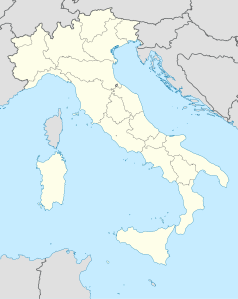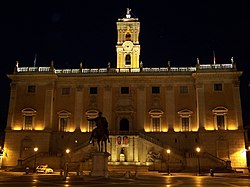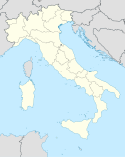Muzea Kapitolińskie
 Pałac Konserwatorów (wł. Palazzo dei Conservatori). | |
| Państwo | |
|---|---|
| Miejscowość | |
| Adres | Piazza del Campidoglio, 1 |
| Data założenia | 1471 |
| Strona internetowa | |
Muzea Kapitolińskie (wł. Musei Capitolini) – grupa muzeów archeologicznych i sztuki znajdujących się przy placu na Kapitolu (Piazza del Campidoglio) w Rzymie (Włochy).
Pierwsze zbiory zostały podarowane miastu przez Sykstusa IV w 1471 r. Pochodzą one z kolekcji zgromadzonej w Pałacu Laterańskim. Mecenas kolejnych papieży i eksponaty odnalezione podczas prac wykopaliskowych pozwoliły zgromadzić bogatą kolekcję rzeźb antycznych. Do najciekawszych eksponatów należą m.in.:
- Amor i Psyche – rzeźba grecka z III wieku p.n.e.,
- Faun – kopia greckiej rzeźby wykonana w II wieku
- Dwa centaury z willi Hadriana – kopie greckich rzeźb
- Wenus Kapitolińska – kopia greckiej rzeźby z IV wieku p.n.e.
- pozostałości kolosalnego posągu Konstantyna z bazyliki Maksencjusza
- Umierający Gal.
Wśród eksponatów można również zobaczyć oryginały Wilczycy kapitolińskiej i konnego pomnika Marka Aureliusza (na zewnątrz znajdują się kopie).
Do kolekcji muzealnej należy także Pinakoteka Kapitolińska założona przez Benedykta XIV w połowie XVIII wieku.
Media użyte na tej stronie
Autor: Dr. Blofeld, insert originally by Nordnordwest, Licencja: CC BY-SA 2.0
Map of Rome. Italy
Geographic limits of the map:
- N: 41.993°
- S: 41.792°
- W: 12.308°
- E: 12.685°
Autor: NordNordWest, Licencja: CC BY-SA 3.0
Location map of Italy (Commons photos) → en-Wikipedia Italy.
Autor:
- Map_of_region_of_Lazio,_Italy.svg: User:Vonvikken
- derivative work: Milenioscuro (talk)
Location map of Lazio region (Italy)
Autor:
Equestrian statue of Marcus Aurelius, roman artwork.
Autor: Marie-Lan Nguyen, Licencja: CC BY 2.5
Eros Stringing his Bow, a Roman copy from the Capitoline Museum of a Greek original by Lysippos; 2nd century AD; marble; height: 123 cm; Capitoline Museum, Rome
Head of Medusa. Marble, 1630.
Head of Emperor Constantine I, part of a colossal statue. Bronze, Roman artwork, 4th century CE, Musei Capitolini, Rome. Formerly at the Lateran Palace; gift of Sixtus IV, 1471.
Lupa Capitolina: she-wolf with Romulus and Remus. Bronze, 13th century AD[1] (the twins are a 15th-century addition).
Autor: Rosemania, Licencja: CC BY 2.0
Situated in the upper part of the Esquilino, in the area around what is today Piazza Vittorio Emanuele, the Horti Lamiani (Lamiani Garden) were founded by the consul Aelius Lamia, a friend of Tiberius, and very soon (already with Caligula) became part of Imperial property. Of the luxurious decorations of this vast complex of buildings, excavated in the 19th century and then covered over again, over and above the frescos and architectural elements in coloured marbles, a countless number of foils in gilded bronze with gems set in them, the remains of a sumptuous wall dressing, were found. Capitoline Museum, Rome.
Autor:
| Feel free to use my photos, but please mention me as the author and send me a message. |
This image is not public domain. Please respect the copyright protection. It may only be used according to the rules mentioned here. This specifically excludes use in social media, if applicable terms of the licenses listed here not appropriate.
|

| Please do not upload an updated image here without consultation with the Author. The author would like to make corrections only at his own source. This ensures that the changes are preserved.
Please if you think that any changes should be required, please inform the author. Otherwise you can upload a new image with a new name. Please use one of the templates derivative or extract. |
The Marforio in the Capitoline Museums in Rome.
Autor:
| Feel free to use my photos, but please mention me as the author and send me a message. |
This image is not public domain. Please respect the copyright protection. It may only be used according to the rules mentioned here. This specifically excludes use in social media, if applicable terms of the licenses listed here not appropriate.
|

| Please do not upload an updated image here without consultation with the Author. The author would like to make corrections only at his own source. This ensures that the changes are preserved.
Please if you think that any changes should be required, please inform the author. Otherwise you can upload a new image with a new name. Please use one of the templates derivative or extract. |
The Satiro Della Valle marble statue in the Capitoline Museums in Rome.
Autor: Yair Haklai, Licencja: CC BY-SA 3.0
Faun in rouge antique marble 2nd century AC - From an original of late hellenistic period Rouge antique marble
cm 167,5 at Musei Capitolini.The Spinario or Thorn-Puller. Greek artwork of the Late Helelnistic era after classical and hellenistic models.
Autor: Alessio Damato, Licencja: CC BY-SA 3.0
Parts of the huge statue of Constantinus I in the Capitolini museum in Rome, Italy
Autor:
| Feel free to use my photos, but please mention me as the author and send me a message. |
This image is not public domain. Please respect the copyright protection. It may only be used according to the rules mentioned here. This specifically excludes use in social media, if applicable terms of the licenses listed here not appropriate.
|

| Please do not upload an updated image here without consultation with the Author. The author would like to make corrections only at his own source. This ensures that the changes are preserved.
Please if you think that any changes should be required, please inform the author. Otherwise you can upload a new image with a new name. Please use one of the templates derivative or extract. |
Cupid and Psyche marble statue in the Capitoline Museums in Rome.

































